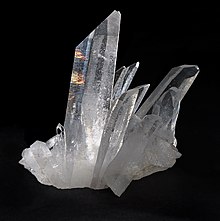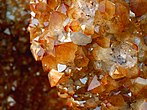Quartz
| Quartz | |
|---|---|
 Quartz crystal cluster from Tibet | |
| General | |
| Category | silicate mineral[1] |
| Formula (repeating unit) | SiO2 |
| IMA symbol | Qz[2] |
| Strunz classification | 4.DA.05 (oxides) |
| Dana classification | 75.01.03.01 (tectosilicates) |
| Crystal system | α-quartz: trigonal β-quartz: hexagonal |
| Crystal class | α-quartz: trapezohedral (class 3 2) β-quartz: trapezohedral (class 6 2 2)[3] |
| Space group | α-quartz: P3221 (no. 154)[4] β-quartz: P6222 (no. 180) or P6422 (no. 181)[5] |
| Unit cell | a = 4.9133 Å, c = 5.4053 Å; Z=3 |
| Identification | |
| Formula mass | 60.083 g·mol−1 |
| Color | Colorless through various colors to black |
| Crystal habit | 6-sided prism ending in 6-sided pyramid (typical), drusy, fine-grained to microcrystalline, massive |
| Twinning | Common Dauphine law, Brazil law and Japan law |
| Cleavage | {0110} Indistinct |
| Fracture | Conchoidal |
| Tenacity | Brittle |
| Mohs scale hardness | 7 – lower in impure varieties (defining mineral) |
| Luster | Vitreous – waxy to dull when massive |
| Streak | White |
| Diaphaneity | Transparent to nearly opaque |
| Specific gravity | 2.65; variable 2.59–2.63 in impure varieties |
| Optical properties | Uniaxial (+) |
| Refractive index | nω = 1.543–1.545 nε = 1.552–1.554 |
| Birefringence | +0.009 (B-G interval) |
| Pleochroism | None |
| Melting point | 1670 °C (β tridymite) 1713 °C (β cristobalite)[3] |
| Solubility | Insoluble at STP; 1 ppmmass at 400 °C and 500 lb/in2 to 2600 ppmmass at 500 °C and 1500 lb/in2[3] |
| Other characteristics | lattice: hexagonal, Piezoelectric, may be triboluminescent, chiral (hence optically active if not racemic) |
| References | [6][7][8][9] |
Quartz is a hard, crystalline mineral composed of silica (silicon dioxide). The atoms are linked in a continuous framework of SiO4 silicon-oxygen tetrahedra, with each oxygen being shared between two tetrahedra, giving an overall chemical formula of SiO2. Quartz is the second most abundant mineral in Earth's continental crust, behind feldspar.[10]
Quartz exists in two forms, the normal α-quartz and the high-temperature β-quartz, both of which are chiral. The transformation from α-quartz to β-quartz takes place abruptly at 573 °C (846 K; 1,063 °F). Since the transformation is accompanied by a significant change in volume, it can easily induce microfracturing of ceramics or rocks passing through this temperature threshold.
There are many different varieties of quartz, several of which are classified as gemstones. Since antiquity, varieties of quartz have been the most commonly used minerals in the making of jewelry and hardstone carvings, especially in Eurasia.
Quartz is the mineral defining the value of 7 on the Mohs scale of hardness, a qualitative scratch method for determining the hardness of a material to abrasion.
Etymology
The word "quartz" is derived from the German word "Quarz", which had the same form in the first half of the 14th century in Middle High German and in East Central German[11] and which came from the Polish dialect term kwardy, which corresponds to the Czech term tvrdý ("hard").[12]
The Ancient Greeks referred to quartz as κρύσταλλος (krustallos) derived from the Ancient Greek κρύος (kruos) meaning "icy cold", because some philosophers (including Theophrastus) apparently believed the mineral to be a form of supercooled ice.[13] Today, the term rock crystal is sometimes used as an alternative name for transparent coarsely crystalline quartz.[14][15]
Crystal habit and structure
Quartz belongs to the trigonal crystal system at room temperature, and to the hexagonal crystal system above 573 °C (846 K; 1,063 °F). The ideal crystal shape is a six-sided prism terminating with six-sided pyramids at each end. In nature quartz crystals are often twinned (with twin right-handed and left-handed quartz crystals), distorted, or so intergrown with adjacent crystals of quartz or other minerals as to only show part of this shape, or to lack obvious crystal faces altogether and appear massive.[16][17] Well-formed crystals typically form as a druse (a layer of crystals lining a void), of which quartz geodes are particularly fine examples.[18] The crystals are attached at one end to the enclosing rock, and only one termination pyramid is present. However, doubly terminated crystals do occur where they develop freely without attachment, for instance, within gypsum.[19]
α-quartz crystallizes in the trigonal crystal system, space group P3121 or P3221 (space group 152 or 154 resp.) depending on the chirality. Above 573 °C (846 K; 1,063 °F), α-quartz in P3121 becomes the more symmetric hexagonal P6422 (space group 181), and α-quartz in P3221 goes to space group P6222 (no. 180).[20] These space groups are truly chiral (they each belong to the 11 enantiomorphous pairs). Both α-quartz and β-quartz are examples of chiral crystal structures composed of achiral building blocks (SiO4 tetrahedra in the present case). The transformation between α- and β-quartz only involves a comparatively minor rotation of the tetrahedra with respect to one another, without a change in the way they are linked.[16][21] However, there is a significant change in volume during this transition, and this can result in significant microfracturing in ceramics[22] and in rocks of the Earth's crust.[23]
Varieties (according to microstructure)
Although many of the varietal names historically arose from the color of the mineral, current scientific naming schemes refer primarily to the microstructure of the mineral. Color is a secondary identifier for the cryptocrystalline minerals, although it is a primary identifier for the macrocrystalline varieties.[24]
| ||||||||||||||||||||||||||||||||||||||||||||||||||||||||||||
Varieties (according to color)
Pure quartz, traditionally called rock crystal or clear quartz, is colorless and transparent or translucent, and has often been used for hardstone carvings, such as the Lothair Crystal. Common colored varieties include citrine, rose quartz, amethyst, smoky quartz, milky quartz, and others.[25] These color differentiations arise from the presence of impurities which change the molecular orbitals, causing some electronic transitions to take place in the visible spectrum causing colors.
The most important distinction between types of quartz is that of macrocrystalline (individual crystals visible to the unaided eye) and the microcrystalline or cryptocrystalline varieties (aggregates of crystals visible only under high magnification). The cryptocrystalline varieties are either translucent or mostly opaque, while the transparent varieties tend to be macrocrystalline. Chalcedony is a cryptocrystalline form of silica consisting of fine intergrowths of both quartz, and its monoclinic polymorph moganite.[26] Other opaque gemstone varieties of quartz, or mixed rocks including quartz, often including contrasting bands or patterns of color, are agate, carnelian or sard, onyx, heliotrope, and jasper.[16]
Amethyst
Amethyst is a form of quartz that ranges from a bright vivid violet to a dark or dull lavender shade. The world's largest deposits of amethysts can be found in Brazil, Mexico, Uruguay, Russia, France, Namibia, and Morocco. Sometimes amethyst and citrine are found growing in the same crystal. It is then referred to as ametrine. Amethyst derives its color from traces of iron in its structure.[27]
Blue quartz
Blue quartz contains inclusions of fibrous magnesio-riebeckite or crocidolite.[28]
Dumortierite quartz
Inclusions of the mineral dumortierite within quartz pieces often result in silky-appearing splotches with a blue hue. Shades of purple or grey sometimes also are present. "Dumortierite quartz" (sometimes called "blue quartz") will sometimes feature contrasting light and dark color zones across the material.[29][30] "Blue quartz" is a minor gemstone.[29][31]
Citrine
Citrine is a variety of quartz whose color ranges from pale yellow to brown due to a submicroscopic distribution of colloidal ferric hydroxide impurities.[32] Natural citrines are rare; most commercial citrines are heat-treated amethysts or smoky quartzes. However, a heat-treated amethyst will have small lines in the crystal, as opposed to a natural citrine's cloudy or smoky appearance. It is nearly impossible to differentiate between cut citrine and yellow topaz visually, but they differ in hardness. Brazil is the leading producer of citrine, with much of its production coming from the state of Rio Grande do Sul. The name is derived from the Latin word citrina which means "yellow" and is also the origin of the word "citron". Sometimes citrine and amethyst can be found together in the same crystal, which is then referred to as ametrine.[33] Citrine has been referred to as the "merchant's stone" or "money stone", due to a superstition that it would bring prosperity.[34]
Citrine was first appreciated as a golden-yellow gemstone in Greece between 300 and 150 BC, during the Hellenistic Age. Yellow quartz was used prior to that to decorate jewelry and tools but it was not highly sought after.[35]
Milky quartz
Milk quartz or milky quartz is the most common variety of crystalline quartz. The white color is caused by minute fluid inclusions of gas, liquid, or both, trapped during crystal formation,[36] making it of little value for optical and quality gemstone applications.[37]
Rose quartz
Rose quartz is a type of quartz that exhibits a pale pink to rose red hue. The color is usually considered as due to trace amounts of titanium, iron, or manganese, in the material. Some rose quartz contains microscopic rutile needles that produce asterism in transmitted light. Recent X-ray diffraction studies suggest that the color is due to thin microscopic fibers of possibly dumortierite within the quartz.[38]
Additionally, there is a rare type of pink quartz (also frequently called crystalline rose quartz) with color that is thought to be caused by trace amounts of phosphate or aluminium. The color in crystals is apparently photosensitive and subject to fading. The first crystals were found in a pegmatite found near Rumford, Maine, US and in Minas Gerais, Brazil.[39]
Smoky quartz
Smoky quartz is a gray, translucent version of quartz. It ranges in clarity from almost complete transparency to a brownish-gray crystal that is almost opaque. Some can also be black. The translucency results from natural irradiation acting on minute traces of aluminum in the crystal structure.[40]
Prasiolite
Prasiolite, also known as vermarine, is a variety of quartz that is green in color. Since 1950, almost all natural prasiolite has come from a small Brazilian mine, but it is also seen in Lower Silesia in Poland. Naturally occurring prasiolite is also found in the Thunder Bay area of Canada. It is a rare mineral in nature; most green quartz is heat-treated amethyst.[41]














No comments:
Post a Comment